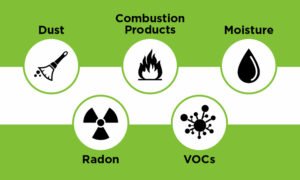HVAC systems are susceptible to a wide range of contaminants, affecting both indoor air quality and the efficiency of the system itself. Here’s a breakdown of the common culprits:
Types of contaminants in HVAC systems:
-
Inanimate particles: These are the most common contaminants, consisting of tiny particles that circulate through the air.
- Dust and dirt: Everyday household dust, tracked-in soil, and other debris accumulate over time.
- Dead skin cells: Human and pet skin cells contribute to the dust load.
- Construction/renovation debris: During home renovations, dust from drywall, insulation, and other materials can enter the HVAC system.
- Other airborne particles: Lint, pollen, and outdoor air pollution can also find their way into the system.
-
Microbial contaminants: Damp and dark environments within the HVAC system create a breeding ground for microbes like:
- Bacteria: Common types include Bacillus, Staphylococci, and Legionella. While some are harmless, others can cause respiratory problems. Legionella is particularly concerning as it can lead to Legionnaires’ disease.
- Mold and fungi: Mold spores can irritate the respiratory system and trigger allergies. Species like Aspergillus, Penicillium, and Cladosporium are frequently found in HVAC systems.
-
Chemical contaminants: These can come from various sources:
- Volatile organic compounds (VOCs): Off-gasing from building materials, paints, cleaning products, and air fresheners can release VOCs into the air.
- Combustion fumes: In homes with fireplaces or gas appliances, incomplete combustion can release harmful fumes like carbon monoxide.
- Pesticides and herbicides: Traces of pesticides or herbicides used outdoors can be drawn inside through the HVAC system.
-
Refrigerant leaks: Damaged refrigerant lines can lead to leaks, releasing harmful and environmentally unfriendly refrigerants into the air.
Effects of contaminants in HVAC systems:
- Reduced indoor air quality: Contaminants can irritate the respiratory system, worsen allergies and asthma, and even cause respiratory illnesses.
- Reduced system efficiency: Clogged filters and dirty coils hinder airflow and make the system work harder, leading to higher energy consumption and potential breakdowns.
- Corrosion: Moisture and contaminants can corrode HVAC components, shortening their lifespan and increasing repair costs.
How to minimize contaminants in your HVAC system:
- Regular maintenance:
- Replace air filters according to the manufacturer’s recommendations (usually monthly or quarterly).
- Schedule professional cleaning of the air ducts and other HVAC components at least once a year.
- Moisture control:
- Ensure proper drainage to prevent moisture buildup within the system.
- Consider using a dehumidifier in conjunction with your AC if you live in a humid climate.
- Improve airflow:
- Don’t block vents or restrict airflow around the AC unit.
- Address source of contaminants:
- If you suspect mold growth, address the moisture source and consider professional remediation.
- Minimize the use of VOC-emitting products indoors.

By maintaining your HVAC system and minimizing contaminant sources, you can ensure cleaner air for your home and a more efficient HVAC system.
